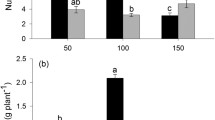Abstract
Growth experiments with macrophytes revealed anomalies in the growth and development of Najas intermedia. Further analyses showed that these anomalies were caused by differences between the male and female plants. To examine the gender-related differences, the results of two field experiments and a phenological monitoring programme were analysed. The field experiments were conducted in four different lakes in Southern Germany. Over the course of 2 years, eight different sediments were used to research the interaction between the gender and the growth of N. intermedia plants. The phenological monitoring programme, on the other hand, was focused on the development of three different populations of N. intermedia in three Southern German lakes. The results of the experiments revealed significant differences in the gender-related development: Depending on the environmental conditions, male plants grew between 20 and 40% faster than female plants. Additionally, the male plants developed flowers earlier in the vegetation period and died before the female plants. As a result, male and female plants coexisted in the same lake only for a short period of time. This might be a strategy to reduce the competitive pressure between the genders and to gain an advantage over rival species.



Similar content being viewed by others
References
Agami, M. & Y. Waisel, 1984. Germination of Najas marina L. Aquatic Botany 19: 37–44.
Agami, M., S. Beer & Y. Waisel, 1980. Growth and photosynthesis of Najas marina L. as affected by light intensity. Aquatic Botany 9: 285–289.
Casper, S. J. & H.-D. Krausch, 1980. Pteridophyta und Anthophyta, 1. Teil Lycopodiaceae bis Orchidaceae. Gustav Fischer Verlag, Stuttgart.
Cox, P. A., 1981. Niche partitioning between sexes of dioecious plants. The American Naturalist 117: 295–307.
Doust, J. L. & G. Laporte, 1991. Population sex ratios, population mixtures and fecundity in a clonal dioecious macrophyte, Vallisneria americana. Journal of Ecology 79: 477–489.
Ellenberg, H., H. E., Düll, R., Wirth, V., Werner, W. & Paulißer, D., 1992. Zeigerwerte von Pflanzen in Mitteleuropa. Erich Goltze GmbH & Co.KG, Göttingen.
Freeman, D. C., L. G. Klikoff & K. T. Harper, 1979. Differential resource utilization by the sexes of dioecious plants. Science 192: 597–599.
Handley, R. & A. J. Davy, 2002. Seedling root establishment may limit Najas marina L. to sediments of low cohesive strength. Aquatic Botany 73: 129–136.
Handley, R. & A. Davy, 2005. Temperature effects on seed maturity and dormancy cycles in an aquatic annual, Najas marina, at the edge of its range. Journal of Ecology 93: 1185–1193.
Hoffmann, M., M. Sacher, S. Lehner, U. Raeder & A. Melzer, 2013. Influence of sediment on the growth of the invasive macrophyte Najas marina ssp. intermedia in lakes. Limnologica 43: 265–271.
Kohler, A., 1978. Methoden der Kartierung von Flora und Vegetation von Süßwasserbiotopen. Landschaft und Stadt 10: 73–85.
Kunachowicz, A., P. Luchniak, M. J. Olszewska & T. Sakowicz, 2001. Comparative karyology, DNA methylation and restriction pattern analysis of male and female plants of the dioecious alga Chara tomentosa (Charophyceae). European Journal of Phycology 36: 29–34.
Lloyd, D. G. & C. J. Webb, 1977. Secondary sex characters in plants. The Botanical Review 43: 177–216.
Ludwig, G. & M. Schnittler, 1996. Rote Liste gefährdeter Pflanzen Deutschlands. Schriftreihe für Vegetationskunde 28: 744.
Melzer, A., 1999. Aquatic macrophytes as tools for lake management. Hydrobiologia 396: 181–190.
Nultsch, W., 2001. Allgemeine Botanik. Georg Thieme Verlag, Stuttgart.
Richter, G., 1997. Stoffwechselphysiologie der Pflanzen Physilogie und Biochemie des Primär- und Sekundärstoffwechsels. Thieme, Stuttgart.
Schaumburg, J., C. Schranz, D. Stelzer & G. Hofmann, 2007. Instructions for the ecological evaluation of lakes for implementation of the EU water framework directive: Makrophytes and Phytobenthos. Bavarian Environment Agency, Munich.
Shuang-Quan, H., G. You-Hao, W. R. Gituru, S. Yao-Hua & S. Kun, 2001. Mechanism of underwater pollination in Najas marina (Najadaceae). Aquatic Botany 70: 67–78.
Schwoerbel, J. & H. Brendelberger, 2005. Einführung in die Limnologie, 9th ed. Auflage-F. München, Elsevier GmbH, Jena.
Sutton, D. L., T. K. Van & K. M. Portier, 1992. Growth of dioecious and monoecious Hydrilla from single tubers. Journal of Aquatic Plant Management 30: 15–20.
Triest, L., 1989. Electrophoretic polymorphism and divergence in Najas marina L. (Najadaceae): molecular markers for individuals, hybrids, cytodemes, lower taxa, ecodemes and conservation of genetic diversity. Aquatic Botany 33: 301–380.
Van Vierssen, W., 1982. Some notes on the germination of seeds of Najas marina L. Aquatic Botany 12: 201–203.
Zhang, S., H. Jiang, S. Peng, H. Korpelainen & C. Li, 2011. Sex-related differences in morphological, physiological, and ultrastructural responses of Populus cathayana to chilling. Journal of Experimental Botany 62: 675–686.
Acknowledgments
This study is part of the Bavarian Research Cooperation FORKAST: Impact of climate on aquatic ecosystems and climatic adaption strategies, funded by the Bavarian State Ministry of Science, Research and the Arts and by the Bavarian State Ministry of the Environment and Public Health. The authors would like to express their sincere gratitude to all of the reviewers and individuals who helped to improve this paper. A special thanks to all scientific divers, students and colleagues of the Limnologische Station Iffeldorf.
Author information
Authors and Affiliations
Corresponding author
Additional information
Handling editor: Sidinei Magela Thomaz
Rights and permissions
About this article
Cite this article
Hoffmann, M., Raeder, U. & Melzer, A. Influence of the gender on growth and phenology of the dioecious macrophyte Najas marina ssp. intermedia . Hydrobiologia 727, 167–176 (2014). https://doi.org/10.1007/s10750-013-1795-z
Received:
Revised:
Accepted:
Published:
Issue Date:
DOI: https://doi.org/10.1007/s10750-013-1795-z




